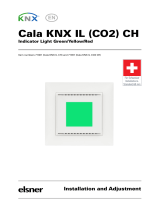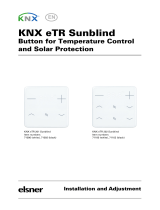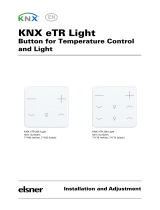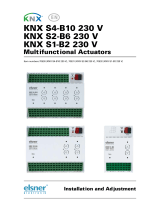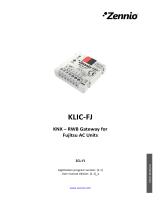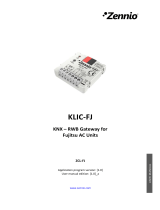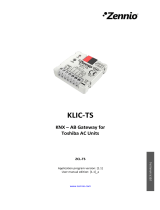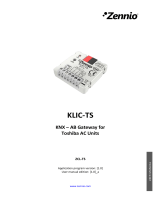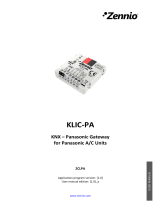Page is loading ...

EN
Installation and Adjustment
Item number 70316
Leak KNX 2.0
Leakage sensor for water and pipe breakage reporting


1 Content
Elsner Elektronik GmbH • Sohlengrund 16 • 75395 Ostelsheim • Germany
Leakage sensor Leak KNX 2.0 • from software version 0.1.2, ETS programme version 1.0 •
Status: 10.07.2023 • Technical changes and errors excepted.
1. Safety and operating instructions ....................................................... 3
2. Description ........................................................................................... 3
2.1. Bus settings ............................................................................................................. 4
3. Addressing the device .......................................................................... 4
4. Transfer protocol ................................................................................. 5
4.1. List of all communication objects ........................................................................... 5
5. Parameter setting ................................................................................ 7
5.1. Behaviour on power failure/ restoration of power ................................................ 7
5.2. General settings ....................................................................................................... 8
5.3. Sensor error .............................................................................................................. 8
5.4. Alarm object ............................................................................................................. 8
5.5. Text object ................................................................................................................ 9
5.6. Signal tone ................................................................................................................ 9
5.7. Logic Inputs .............................................................................................................. 9
5.7.1. AND Logic .................................................................................................... 10
5.7.2. OR Logic ...................................................................................................... 10
5.7.3. AND Logic 1-4 and OR Logic 1-4 ............................................................... 10
5.7.3.1. Block .............................................................................................. 11
5.7.3.2. Monitoring ..................................................................................... 12
5.7.4. Connection inputs of the AND logic .......................................................... 13
5.7.5. Connection inputs of the OR logic ............................................................. 13

2 Clarification of signs
This manual is amended periodically and will be brought into line with new software
releases. The change status (software version and date) can be found in the contents footer.
If you have a device with a later software version, please check
www.elsner-elektronik.de in the menu area "Service" to find out whether a more up-to-
date version of the manual is available.
Clarification of signs used in this manual
Safety advice.
Safety advice for working on electrical connections, components,
etc.
DANGER! ... indicates an immediately hazardous situation which will lead to
death or severe injuries if it is not avoided.
WARNING! ... indicates a potentially hazardous situation which may lead to
death or severe injuries if it is not avoided.
CAUTION! ... indicates a potentially hazardous situation which may lead to
trivial or minor injuries if it is not avoided.
ATTENTION! ... indicates a situation which may lead to damage to property if it is
not avoided.
ETS In the ETS tables, the parameter default settings are marked by
underlining.

3 Safety and operating instructions
Leakage sensor Leak KNX 2.0 • Version: 10.07.2023 • Errors and technical modifications subject to change without notice.
1. Safety and operating instructions
Installation, testing, operational start-up and troubleshooting should
only be performed by an authorised electrician.
CAUTION!
Live voltage!
• Inspect the device for damage before installation. Only put undamaged devic-
es into operation.
• Comply with the locally applicable directives, regulations and provisions for
electrical installation.
• Immediately take the device or system out of service and secure it against un-
intentional switch-on if risk-free operation is no longer guaranteed.
Use the device exclusively for building automation and observe the operating instruc-
tions. Improper use, modifications to the device or failure to observe the operating in-
structions will invalidate any warranty or guarantee claims.
Operate the device only as a fixed-site installation, i.e. only in assembled condition and
after conclusion of all installation and operational start-up tasks, and only in the sur-
roundings designated for it.
Elsner Elektronik is not liable for any changes in norms and standards which may occur
after publication of these operating instructions.
For information on installation, maintenance, disposal, scope of deliv-
ery and technical data, please refer to the installation instructions.
2. Description
The Leakage sensor Leak KNX 2.0 includes an evaluation unit and a probe. If there
is water between the electrodes of the probe, the evaluation unit produces an acoustic
alarm. Additionally, the alarm signal is sent to the KNX bus.
Even if no probe is connected or the cable is defective, the alarm can be sounded and
signalled on the bus.
Functions:
• Detection of water on the probe
• Acoustic alarm signal by the evaluation unit during a water alarm (sustained
beeping tone). Short beeping during the follow-up time (1 minute after the end
of the alarm).
• Alarm signal sent to the KNX bus with a text message
• Detection whether probe is connected and the probe cable is functional
• Acoustic alarm signal on the evaluation unit when the probe is not connected
or when the probe cable is broken (long beeps)

4 Addressing the device
Leakage sensor Leak KNX 2.0 • Version: 10.07.2023 • Errors and technical modifications subject to change without notice.
• 4 AND and 4 OR logic gates with each 4 inputs. Every switching incident as well
as 16 logic inputs in the form of communication objects, may be used as inputs
for the logic gates. The output of each gate may optionally be configured as 1
bit or 2 x 8 bits
2.1. Bus settings
If there is water contact, the evaluation unit submits an acoustical signal and sends an
alarm signal and a text message to the KNX bus. Adjust the setting for these parame-
ters in the ETS.
3. Addressing the device
The device is delivered with the bus address 15.15.255. You can program a different
address in the ETS by overwriting the address 15.15.255 or by teaching the device via
the programming button.
The programming button is inside the case (Fig. 1: No. 3).

5 Transfer protocol
Leakage sensor Leak KNX 2.0 • Status: 10.07.2023 • Technical changes and errors excepted.
4. Transfer protocol
4.1. List of all communication objects
Abbreviations:
R Read
W Write
C Communication
T Transfer
UUpdate
No. Text Function Flags Data Point Type Size
0 Software version Readable R-C- [217.1] DPT_Version 2 Bytes
1 Leakage Sensor error
(1 = On | 0 = Off)
Output R-CT [1.1]
DPT_Switch
1 Bit
2 Leakage alarm
(1 = On | 0 = off)
Output R-CT [1.1]
DPT_Switch
1 Bit
3 Leakage alarm text Output R-CT [16.0]
DPT_String_ASCII
14
Bytes
4 Leakage alarm
Switching-on delay
Input RWCT [7.5]
DPT_TimePeriodSec
2 Bytes
5 Leakage alarm
Switching-off delay
Input RWCT [7.5]
DPT_TimePeriodSec
2 Bytes
6 Leakage alarm signal tone
muting
(1 = mute | 0 = not mute)
Input -WC- [1.1]
DPT_Switch
1 Bit
7 Logic input 1 Input -WC- [1.2]
DPT_Bool
1 Bit
8 Logic input 2 Input -WC- [1.2]
DPT_Bool
1 Bit
9 Logic input 3 Input -WC- [1.2]
DPT_Bool
1 Bit
10 Logic input 4 Input -WC- [1.2]
DPT_Bool
1 Bit
11 Logic input 5 Input -WC- [1.2]
DPT_Bool
1 Bit
12 Logic input 6 Input -WC- [1.2]
DPT_Bool
1 Bit
13 Logic input 7 Input -WC- [1.2]
DPT_Bool
1 Bit
14 Logic input 8 Input -WC- [1.2]
DPT_Bool
1 Bit
15 Logic input 9 Input -WC- [1.2]
DPT_Bool
1 Bit

6 Transfer protocol
Leakage sensor Leak KNX 2.0 • Status: 10.07.2023 • Technical changes and errors excepted.
16 Logic input 10 Input -WC- [1.2]
DPT_Bool
1 Bit
17 Logic input 11 Input -WC- [1.2]
DPT_Bool
1 Bit
18 Logic input 12 Input -WC- [1.2]
DPT_Bool
1 Bit
19 Logic input 13 Input -WC- [1.2]
DPT_Bool
1 Bit
20 Logic input 14 Input -WC- [1.2]
DPT_Bool
1 Bit
21 Logic input 15 Input -WC- [1.2]
DPT_Bool
1 Bit
22 Logic input 16 Input -WC- [1.2]
DPT_Bool
1 Bit
23 AND Logic 1: 1 Bit swit-
ching output
Output R-CT [1.2]
DPT_Bool
1 Bit
24 AND Logic 1: 8 Bit output A Output R-CT Depending on setting 1 Byte
25 AND Logic1: 8 Bit output B Output R-CT Depending on setting 1 Byte
26 AND Logic 1: block Output -WC- [1.1]
DPT_Switch
1 Bit
27 AND Logic 2: 1 Bit swit-
ching output
Output R-CT [1.2]
DPT_Bool
1 Bit
28 AND Logic2: 8 Bit output A Output R-CT Depending on setting 1 Byte
29 AND Logic2: 8 Bit output B Output R-CT Depending on setting 1 Byte
30 AND Logic 2: block Input -WC- [1.1]
DPT_Switch
1 Bit
31 AND Logic 3: 1 Bit swit-
ching output
Output R-CT [1.2]
DPT_Bool
1 Bit
32 AND Logic 3: 8 Bit output A Output R-CT Depending on setting 1 Byte
33 AND Logic 3: 8 Bit output B Output R-CT Depending on setting 1 Byte
34 AND Logic 3: block Input -WC- [1.1]
DPT_Switch
1 Bit
35 AND Logic 4: 1 Bit swit-
ching output
Output R-CT [1.2]
DPT_Bool
1 Bit
36 AND Logic 4: 8 Bit output A Output R-CT Depending on setting 1 Byte
37 AND Logic 4: 8 Bit output B Output R-CT Depending on setting 1 Byte
38 AND Logic 4: block Output -WC- [1.1]
DPT_Switch
1 Bit
39 OR Logic 1: 1 Bit switching
output
Output R-CT [1.2]
DPT_Bool
1 Bit
40 OR Logic 1: 8 Bit output A Output R-CT Depending on setting 1 Byte
41 OR Logic 1: 8 Bit output B Output R-CT Depending on setting 1 Byte
No. Text Function Flags Data Point Type Size

7 Parameter setting
Leakage sensor Leak KNX 2.0 • Status: 10.07.2023 • Technical changes and errors excepted.
5. Parameter setting
The default settings of the parameter are labelled by an underscore.
5.1. Behaviour on power failure/ restoration of
power
Behaviour following a failure of the bus power supply:
The device sends nothing.
Behaviour on bus restoration of power and following programming or reset:
The device sends all outputs according to their send behaviour set in the parameters
with the delays established in the "General settings" parameter block. The "Software
version" communications object is sent once after 5 seconds.
42 OR Logic 1: block Input -WC- [1.1]
DPT_Switch
1 Bit
43 OR Logic 2: 1 Bit switching
output
Output R-CT [1.2]
DPT_Bool
1 Bit
44 OR Logic 2: 8 Bit output A Output R-CT Depending on setting 1 Byte
45 OR Logic 2: 8 Bit output B Output R-CT Depending on setting 1 Byte
46 OR Logic 2: block Input -WC- [1.1]
DPT_Switch
1 Bit
47 OR Logic 3: 1 Bit switching
output
Output R-CT [1.2]
DPT_Bool
1 Bit
48 OR Logic 3: 8 Bit output A Output R-CT Depending on setting 1 Byte
49 OR Logic 3: 8 Bit output B Output R-CT Depending on setting 1 Byte
50 OR Logic 3: block Input -WC- [1.1]
DPT_Switch
1 Bit
51 OR Logic 4: 1 Bit switching
output
Output R-CT [1.2]
DPT_Bool
1 Bit
52 OR Logic 4: 8 Bit output A Output R-CT Depending on setting 1 Byte
53 OR Logic 4: 8 Bit output B Output R-CT Depending on setting 1 Byte
54 OR Logic 4: block Input -WC- [1.1]
DPT_Switch
1 Bit
No. Text Function Flags Data Point Type Size

8 Parameter setting
Leakage sensor Leak KNX 2.0 • Status: 10.07.2023 • Technical changes and errors excepted.
5.2. General settings
First, set the general parameters for the bus communication (transmission delay).
When labelling objects, you can enter an additional label (abbreviation) for the objects
of the device, e.g. ‘LR’ for ‘living room’, to make the room installation more transpa-
rent.
5.3. Sensor error
Set the send behaviour of the sensor error object.
5.4. Alarm object
If the sensor detects water, this always leads to an alarm. Set whether a sensor error
is also reported as an alarm. Adjust the setting for the alarm object. Define the sending
behaviour and the object value.
Send delay in seconds after reset and
voltage returns
5 ...7200
Maximum telegram quota • 1 message per second
• ...
• 10 messages per second
• ...
• 50 message per second
Object labelling [Free text]
Send behaviour of the sensor error object • not
• on change
• on change and periodically
Send cycle
(if sent periodically)
5 s • ... • 5 min • ... • 2 h
Report sensor error as alarm No • Yes
Alarm object sending behaviour • not
• on change
• on change and alarm on
• on change and alarm off
• on change and periodically
• on change to alarm on and periodically
• on change to alarm off and periodically
Send cycle 5 s • ... • 10 s • ... • 2 h
Analysis of alarm object • 0 = alarm off | 1 = alarm on
• 1 = alarm off | 0 = alarm on
Adjust alarm delay via object No • Yes
Maintain delays received via objects • never be retained
• after power restoration
• after power restoration and
programming

9 Parameter setting
Leakage sensor Leak KNX 2.0 • Status: 10.07.2023 • Technical changes and errors excepted.
5.5. Text object
When an alarm is issued, a text message is transmitted to the KNX bus. Adjust the pa-
rameters for the sending behaviour. You can insert your own text that is shown during
alarm on or alarm off.
5.6. Signal tone
Define the behaviour and the object value of the signal tone.
5.7. Logic Inputs
The device has 16 logic inputs, four AND and four OR logic gates. Activate the logic in-
puts and assign object values up to 1st communication.
Object value before 1st communication
Delay for alarm on
(until 1. communication)
0 s • ... • 10 s • ... • 2 h
Delay for alarm off
(until 1. communication)
0 s • ... • 10 s • ... • 2 h
Alarm object sending behaviour • not
• on change
• on change and alarm on
• on change and alarm off
• on change and periodically
• on change to alarm on and periodically
• on change to alarm off and periodically
Send cycle 5 s • ... • 10 s • ... • 2 h
Text for alarm on [Free text]
Text for alarm off [Free text]
Use signal tone No • Yes
Use muting No • Yes
Duration of muting in seconds
(the signal tone is repeated if the alarm is
still on after this time)
5 ... 600, 60
Object analysis 1 = alarm mute | 0 = alarm not mute
0 = alarm mute | 1 = alarm not mute
Use logic inputs No • Yes
Logic input 1 0 • 1
Logic input 2 0 • 1
Logic input ... 0 • 1
Logic input 16 0 • 1

10 Parameter setting
Leakage sensor Leak KNX 2.0 • Status: 10.07.2023 • Technical changes and errors excepted.
5.7.1. AND Logic
Activate the required logic outputs.
5.7.2. OR Logic
Activate the required logic outputs.
5.7.3. AND Logic 1-4 and OR Logic 1-4
AND and OR logic gates provide the same setting options. Each logic output can send
1-bit or 8-bit objects. Chose what the output sends at logic = 1 and = 0.
Adjust the output values for different states for the one 1-bit object.
AND Logic 1 not active • active
AND Logic 2 not active • active
AND Logic 3 not active • active
AND Logic 4 not active • active
OR Logic 1 not active • active
OR Logic 2 not active • active
OR Logic3 not active • active
OR Logic 4 not active • active
1. / 2. / 3. / 4. Input • do not use
• Logic input 1...16
• Logic input 1...16 inverted
• all switching events which are available to
the device
(see chapter connection inputs of the AND
or Or logic)
Logic output sends • one 1-bit object
• two 8-bit objects
Output value
if logic = 1
1 • 0
Output value
if logic = 0
1 • 0
Output value
if block is active
1 • 0
Output value
if monitoring period is exceeded
1 • 0

11 Parameter setting
Leakage sensor Leak KNX 2.0 • Status: 10.07.2023 • Technical changes and errors excepted.
Adjust the object type and output values for different states for the two 8-bit objects.
Adjust the sending behaviour of the output.
Block
Activate the block of the logic output if needed and adjust what 1 or 0 means for the
inhibiting input and what happens while blocking.
Object type • Value (0…255)
• Percent (0…100%)
• Angle (0…360°)
• Scenario load (0…63)
Output value object A
if logic = 1
0 … 255 / 100% / 360° / 63; 1
Output value object B
if logic = 1
0 … 255 / 100% / 360° / 63; 1
Output value object A
if logic = 0
0 … 255 / 100% / 360° / 63; 0
Output value object B
if logic = 0
0 … 255 / 100% / 360° / 63; 0
Output value object A
if block is active
0 … 255 / 100% / 360° / 63; 0
Output value object B
if block is active
0 … 255 / 100% / 360° / 63; 0
Output value object A
if monitoring period is exceeded
0 … 255 / 100% / 360° / 63; 0
Output value object B
if monitoring period is exceeded
0 … 255 / 100% / 360° / 63; 0
Send behaviour • on change of logic
• on change of logic to 1
• on change of logic to 0
• on change of logic and periodically
• on change of logic to 1 and periodically
• on change of logic to 0 and periodically
• on change of logic + receipt of object
• on change of logic + receipt of object and
periodically
Send cycle
(is only sent if "periodically" is selected)
5 s • 10 s • ... • 2 h
Use block No • Yes
Blocking object analysis • at value 1: block | at value 0: release
at value 0: block | at value 1: release
Blocking object value before 1st communi-
cation
0 • 1
Output behaviour

12 Parameter setting
Leakage sensor Leak KNX 2.0 • Status: 10.07.2023 • Technical changes and errors excepted.
Monitoring
If necessary, activate the input monitoring. Set which inputs are to be monitored, at
which intervals the inputs are to be monitored and what value the "monitoring status"
should have, if the monitoring period is exceeded without feedback.
With blocking • do not send message
• Send blocking value [look above,
output value when block is active]
On release
(with 2 seconds release delay)
[send value for current logic state]
Use input monitor No • Yes
Monitor input • 1 • 2 • 3 • 4
• 1 + 2 • 1 + 3 • 1 + 4 • 2 + 3 • 2 + 4 • 3 + 4
• 1 + 2 + 3 • 1 + 2 + 4 • 1 + 3 + 4 • 2 + 3 + 4
• 1 + 2 + 3 + 4
Monitoring period 5 s • ... • 2 h; 1 min
Value of the object "monitoring status"
if period is exceeded
• do not send message
• send exceeding value [= value of the para-
meter „monitoring period“]

13 Parameter setting
Leakage sensor Leak KNX 2.0 • Status: 10.07.2023 • Technical changes and errors excepted.
5.7.4. Connection inputs of the AND logic
do not use
Logic input 1
Logic input 1 inverted
Logic input 2
Logic input 2 inverted
Logic input 3
Logic input 3 inverted
Logic input 4
Logic input 4 inverted
Logic input 5
Logic input 5 inverted
Logic input 6
Logic input 6 inverted
Logic input 7
Logic input 7 inverted
Logic input 8
Logic input 8 inverted
Logic input 9
Logic input 9 inverted
Logic input 10
Logic input 10 inverted
Logic input 11
Logic input 11 inverted
Logic input 12
Logic input 12 inverted
Logic input 13
Logic input 13 inverted
Logic input 14
Logic input 14 inverted
Logic input 15
Logic input 15 inverted
Logic input 16
Logic input 16 inverted
Leakage alarm ON
Leakage alarm OFF
5.7.5. Connection inputs of the OR logic
do not use
Logic input 1
Logic input 1 inverted
Logic input 2
Logic input 2 inverted
Logic input 3
Logic input 3 inverted
Logic input 4

14 Parameter setting
Leakage sensor Leak KNX 2.0 • Status: 10.07.2023 • Technical changes and errors excepted.
Logic input 4 inverted
Logic input 5
Logic input 5 inverted
Logic input 6
Logic input 6 inverted
Logic input 7
Logic input 7 inverted
Logic input 8
Logic input 8 inverted
Logic input 9
Logic input 9 inverted
Logic input 10
Logic input 10 inverted
Logic input 11
Logic input 11 inverted
Logic input 12
Logic input 12 inverted
Logic input 13
Logic input 13 inverted
Logic input 14
Logic input 14 inverted
Logic input 15
Logic input 15 inverted
Logic input 16
Logic input 16 inverted
Leakage alarm ON
Leakage alarm OFF
Switching output and logic 1
Switching output and logic 1 inverted
Switching output and logic 2
Switching output and logic 2 inverted
Switching output and logic 3
Switching output and logic 3 inverted
Switching output and logic 4
Switching output and logic 4 inverted


Elsner Elektronik GmbH Control and Automation Engineering
Sohlengrund 16
Germany Fax +49 (0) 70 33 / 30 945-20 www.elsner-elektronik.de
You can reach the technical service of Elsner Elektronik under
Tel. +49 (0) 70 33 / 30 945-250 or
We need the following information to process your service request:
• Type of appliance (model name or item number)
• Description of the problem
• Serial number or software version
• Source of supply (dealer/installer who bought the device from Elsner
Elektronik)
For questions about KNX functions:
• Version of the device application
• ETS version used for the project
Questions about the product?
/
